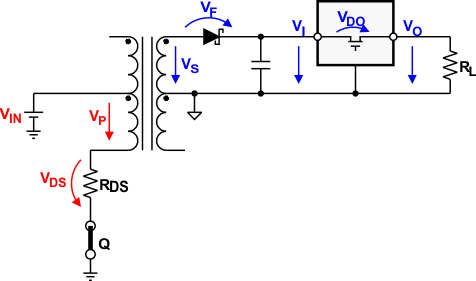ZHCSND7 September 2022 SN6507-Q1
PRODUCTION DATA
- 1 特性
- 2 应用
- 3 说明
- 4 Revision History
- 5 Pin Configuration and Functions
- 6 Specifications
- 7 Parameter Measurement Information
- 8 Detailed Description
- 9 Application and Implementation
- 10Device and Documentation Support
- 11Mechanical, Packaging, and Orderable Information
9.2.2.5.2 Turns Ratio Estimate
From previous section, it has been determined that the transformer chosen must have a V-t product of 15 Vμs. However, before searching the manufacturer web sites for a suitable transformer, the user still needs to know its minimum turns ratio that allows the push-pull converter to operate flawlessly over the specified current and temperature range. This minimum transformation ratio is expressed through the ratio of minimum secondary to minimum primary voltage multiplied by a correction factor that takes the transformer’s typical efficiency of 97% into account:
VS-min must be large enough to allow for a maximum voltage drop, VF-max, across the rectifier diode and still provide sufficient input voltage for the regulator to remain in regulation. From the Section 9.2.2.2 section, this minimum input voltage is known and by adding VF-max gives the minimum secondary voltage with:
 Figure 9-5 Establishing the Required Minimum Turns Ratio Through Nmin = 1.03 × VS-min / VP-min
Figure 9-5 Establishing the Required Minimum Turns Ratio Through Nmin = 1.03 × VS-min / VP-minThen calculating the available minimum primary voltage, VP-min, involves subtracting the maximum possible drain-source voltage of the device, VDS-max, from the minimum converter input voltage VIN-min:
VDS-max however, is the product of the maximum RDS(on) and ID values for a given supply specified in the data sheet:
Then inserting Equation 16 into Equation 15 yields:
and inserting Equation 17 and Equation 14 into Equation 13 provides the minimum turns ration with:
Examples are given on the calculation method. One is for the fixed input case without duty cycle control. The other is for the wide-ranging input, with or without duty cycle control.
Example of Fixed Input:
For a fixed 24 V VIN to 15 VOUT converter using the rectifier diode PMEG200G20ELRX and the LM317A LDO, the data sheet values taken for a load current of 500mA and a maximum temperature of 85°C are VF-max = 0.5 V,
VDO-max = 0.7 V, and VO-max = 15.15 V.
Then assuming that the converter input voltage is taken from a 24V regulated supply with a maximum ±2% accuracy makes VIN-min = 23.52 V. Finally the maximum values for drain-source resistance and drain current at 24 V are taken from the data sheet with RDS-max = 1 Ω and ID-max = 0.5 A.
Inserting the values above into the Equation above yields a minimum turns ratio of:
Example of Wide-Ranging Input:
- Wide-Ranging Input without Duty-Cycle Control
For converter designs with wide-input range but no duty cycle control, the turns ratio needs to take the minimum input voltage into consideration.
Assuming the same diode and LDO are used, the calculation, so VF-max = 0.5 V, VDO-max = 0.7 V, and VO-max = 15.15 V.
The input range from 18 V up to 30 V makes VIN-min = 18 V. The input range from 18 V up to 30 V with 24 V typical makes VIN-min = 18 V. Substituting the same RDS-max = 1 Ω and ID-max = 0.5 A into the Equation above yields to a minimum turns ratio of:
- Wide-Ranging Input with Duty-Cycle Control
For converter designs with wide-input range, the duty cycle feature is useful to compensate input variaton. But care must be taken to make sure that high turns ratios don’t lead to primary currents that exceed the specified current limits of the device.
Assuming the same diode and LDO are used, so VF-max = 0.5 V, VDO-max = 0.7 V, and VO-max = 15.15 V.
It's recommends the use to set the DC=25% at typical VIN-typ = 24 V. Substituting the same RDS-max = 1 Ω and ID-max = 0.5 A into the Equation above yields to a minimum turns ratio of: